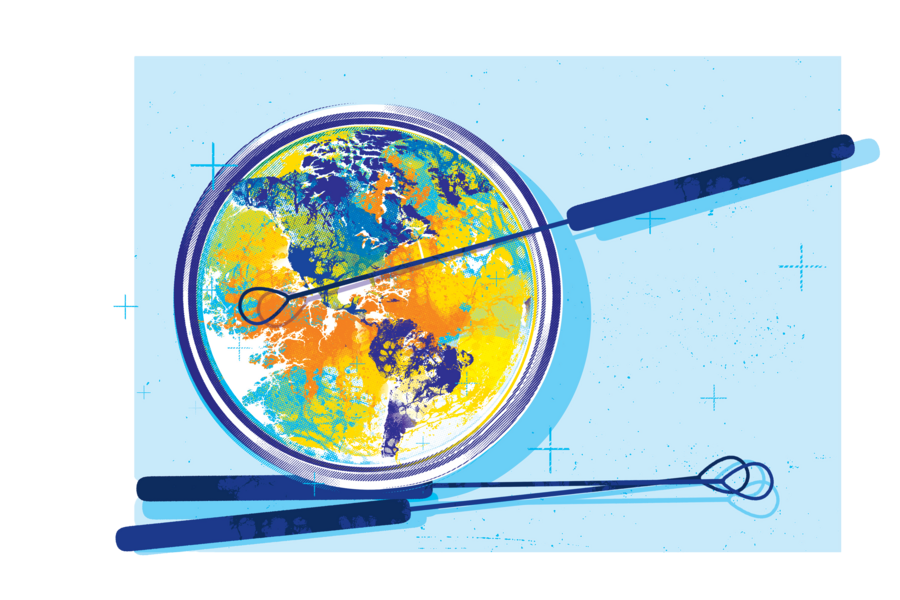Bats play a vital role in our ecosystem. They pollinate plants, disperse seeds, and protect crops from pests. But more than 90% of three North American bat species no longer perform these functions, having died of "white-nose syndrome," a fungal disease discovered in upstate New York in 2006 that still ravages bat colonies today.
Something similar is happening with bananas. A strain of the fungus Fusarium oxysporum wiped out Taiwanese banana farms in the late 20th century. From there, the pathogen spread to other places—Mozambique, Colombia—and now threatens 80% of the world's most consumed fruit.
These developments are described in gripping detail in What If Fungi Win?, a new book by Arturo Casadevall, a world-renowned infectious disease doctor and chair of the Johns Hopkins Department of Molecular Microbiology and Immunology at the Bloomberg School of Public Health. Written in partnership with science journalist Stephanie Desmon, A&S '22 (MA), the book offers a primer on the stealthy organisms that exist all around us and can thrive on mountaintops and in deep oceans alike.
Casadevall says we know far too little about the 6 million (and counting) identified fungal species and their uncanny ability to nourish and, at times, destroy not just plants and mammals but also our food supply and health. To this end, the author says he "hopes the book helps people learn about this remarkable set of organisms that are essential for life and sources of medicines and fermented beverages like the wine I'll drink tonight."
Published as part of the Wavelengths series by Johns Hopkins University Press, What If Fungi Win? delves into the many positives of fungi—from bolstering the mind and gut to biodegrading plastics. But it focuses more heavily on emerging downsides triggered by factors like climate change and modern medicine, "which few realize and not enough scientists are investigating," he says. In this sense, his book is a wake-up call to the dire need for more fungi research—a move that could save not just bats and bananas but also our entire planet.
"We have a huge blind spot when it comes to the diseases and toxins fungi can wield," Casadevall writes. "We need to stop ignoring fungi and the threats they pose, treating them as less dangerous than bacteria or viruses, … as second-class citizens in the world of pathogens."
In the last few decades, fungal pathogens have evolved to wreak havoc in unprecedented ways, putting at risk essentials such as our global food supply. Fast-growing fungal blasts now threaten global supplies of wheat, corn, and rice, three staples that make up 40% of the total calories consumed by humans. A reason?
"Earth is heating up, and everything that lives here either has to die or adapt to the warmer temperatures and increased natural disasters, including fungi, which are temperature-dependent," he explains. Scientists haven't figured out precisely how climate change affects fungi, he adds, but they're seeing repercussions everywhere—even in humans.
"We're generally protected from fungal pathogens by our hot temperature of 98.6 degrees; most fungi cannot grow on us, period," he says. But as his book explains, a Stanford University study from 2020 identified a slight but significant decline in average human temperatures in the United States. Why?
"The best hypothesis is that with modern medicine and better standards of living, we may not need to be as warm," Casadevall writes. "Our bodies produce inflammation and heat up to fight off disease, but with tuberculosis and other diseases far less common, sanitation and living conditions improved, and the rise in the use of antibiotics, we're experiencing fewer stressors and so need to produce less protective heat." This, in turn, could lead to "an uncomfortable showdown: humans getting cooler just as new fungi are adapting to higher temperatures," his book continues.
Most of us know about common fungal infections like ringworm and athlete's foot, but fungi now cause serious problems in humans, especially immunocompromised individuals but even, in rare cases, those without health problems, Casadevall says. For instance, no one had heard of Candida auris until 2009, when it infested the external ear canal of a 70-year-old woman in Japan, before manifesting in countries worldwide. The age-old fungus had coexisted in our environment but gone undetected for thousands of years, without causing harm to humans, scientists contend. Now, it's growing rampantly.
Also see
In the U.S. alone, cases rose 44% in 2019 and a staggering 95% in 2021, according to the CDC. Worse yet, antifungal treatments do not work well on C. auris, which has evolved to "grow in temperatures as high as 107.6 degrees," Casadevall writes.
C. auris is far from the only fungal pathogen evolving in ways that harm humans. "Each year, fungal pathogens … sicken more than 150 million [people worldwide] with serious or invasive disease and are responsible for 1.5 million deaths," the book says. "But public health surveillance of most fungal disease is not mandatory everywhere—not even in the United States—suggesting that these estimates are conservative."
How can we combat this peril? It starts with recognizing climate change as a threat to humanity, the author stresses. It also involves remembering what Casadevall spells out as a key theme of the book: "Science is humanity's best insurance policy."
Posted in Health








